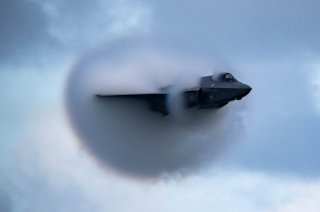How to Improve the Design of Stealth Fighter Jets and Helicopters
Cutting-edge aerodynamic research and new innovations will greatly improve aerodynamic performance for future aircraft.
Why do available renderings of sixth-generation fighter aircraft show fewer vertical structures, fins or protruding configurations? Are scientists, engineers and expert weapons developers uncovering new aerodynamic development likely to improve aircraft design configurations to massively enhance performance?
Information about the aerodynamic design configuration for future stealth fighter jets or helicopters will unlikely be available for security reasons. But there is some cutting-edge aerodynamic research available to academicians and new innovations able to greatly improve aerodynamic performance for future aircraft.
Certainly, a more horizontal-looking sixth-generation fighter jet, absent protruding structures such as tailfins, weapons pylons or sharp-angled fuselage structures would make an aircraft stealthier. Additionally, electromagnetic pings would have fewer shapes to bounce off and therefore be less likely to produce an accurate rendering. Fewer extended external structures and blended wing-body configurations all naturally improve stealth performance characteristics. Perhaps engineers have discovered ways to turn, maneuver, vector or operate in the air without needing as many tailfins or distinctly separated wing structures. What might make this possible? Breakthroughs in the area of aerodynamics related to “boundary layer,” or “airflow” management.
When fast-moving vortices, or “masses of whirling air” collide, large amounts of turbulence can be generated, then they are often sufficient to fully derail intended aerial maneuvers.
Yet, apart from the question of potentially enhancing stealth properties, there is another key reason why engineers succeed in creating more effective and higher-performing aircraft; designers continue to uncover new methods of directing, managing or controlling “airflow” surrounding an air vehicle, a phenomenon, of course, critical to flight stability. Should an aircraft’s surrounding airflow or “boundary layer” be directed or managed for optimal performance, then an aircraft can fly faster and smoother with much less turbulence.
This is something of critical significance to Army scientists who are working with academia to discover cutting-edge computer simulation technologies able to precisely replicate aerodynamic phenomena such as the way in which airflow can impact turbulence. Turbulence in flight is as common as it is both complex and somewhat mysterious. It can massively destabilize an aircraft’s flight trajectory and even cause it to “lose lift” and crash. Airflow management is vital to flight stability and aerial performance in key areas such as high-speed maneuvering or sharp angle vectoring in combat. So-called “friction” or disruption in the “boundary layer” can throw an aircraft off course. A “laminar” or smooth, airflow boundary layer can optimize flight performance, whereas a turbulent boundary layer can cause significant flight stability programs for aircraft.
These areas of current inquiry are intended, among other things, to generate new possibilities in the realm of air vehicle design sufficient to achieve a new generation of higher-performing aircraft less encumbered by turbulence.
The Army Research Office funded researchers at Purdue University to advance a turbulence model known as the Coherent-vorticity-Preserving Large-Eddy Simulation. Published in the Journal of Fluid Mechanics, the new methodology simulates the entire process of a vortex collision event up to one hundred times faster than current state-of-the-art simulation techniques.
Researchers with the Army and Purdue University are able to simulate these kinds of collisions, wherein vortices intersect or essential “run into” one another and collide, a process which enables them to closely study the kinds of aerodynamic phenomena essential to generate a smooth or “laminar” air flow.
“When engineers are designing the latest greatest transport plane, fighter jet or helicopter, they have to use computer models to try to understand the flow around the design . . . and they have to make some choices about how they account for turbulence,” Dr. Matthew Munson, the program manager at the Army Research Office under the umbrella Army Futures Command, told the National Interest.
Munson described it as building up an understanding of the air flow surrounding an entire vehicle to analyze, refine or enhance aerodynamic performance variables.
“Once I have an understanding of the flow over the entire vehicle, I can start to do things like compute ‘lift’ and ‘drag’ . . . and I can compute the thrust needed and I can compute how much the airplane can weigh. I can compute what kinds of forces are required to turn the aircraft from straight and level to a diving or climbing position,” Munson explained. “Each of these things requires some treatment of the turbulent flow.”
What might the end result of all of this be? Simply put: new air vehicles. This kind of research and innovation could very well drive engineers to design conclusions for a seventh-generation aircraft someday or create an entirely new kind of high-speed, hovering attack helicopter.
“If you’re able to accurately simulate the thousands of events in flow like those coming from a helicopter blade, you could engineer much more complex systems,” Carlo Scalo, a Purdue associate professor of mechanical engineering, said in an Army Research Laboratory report.
Kris Osborn is the defense editor for the National Interest. Osborn previously served at the Pentagon as a Highly Qualified Expert with the Office of the Assistant Secretary of the Army—Acquisition, Logistics & Technology. Osborn has also worked as an anchor and on-air military specialist at national TV networks. He has appeared as a guest military expert on Fox News, MSNBC, The Military Channel, and The History Channel. He also has a Master's Degree in Comparative Literature from Columbia University.
Image: Reuters

